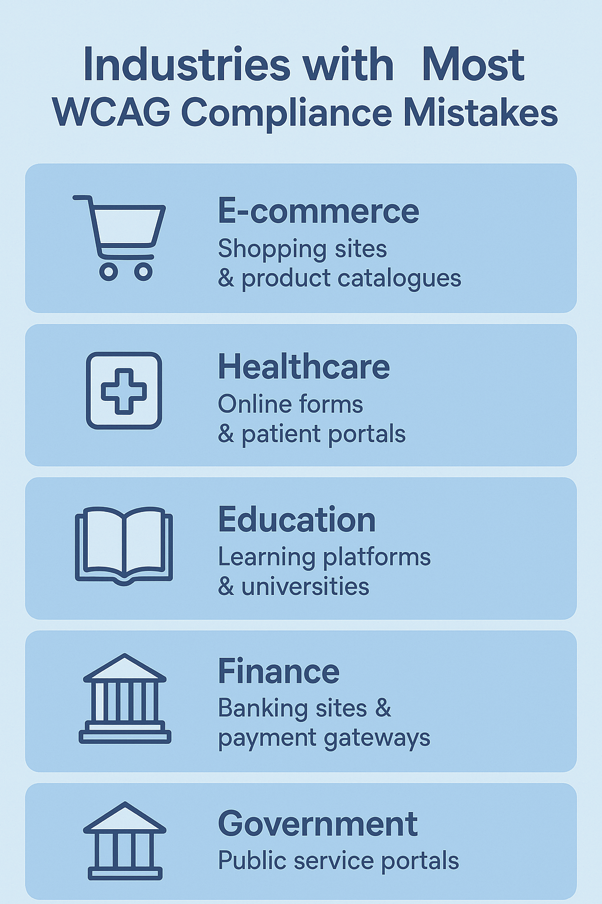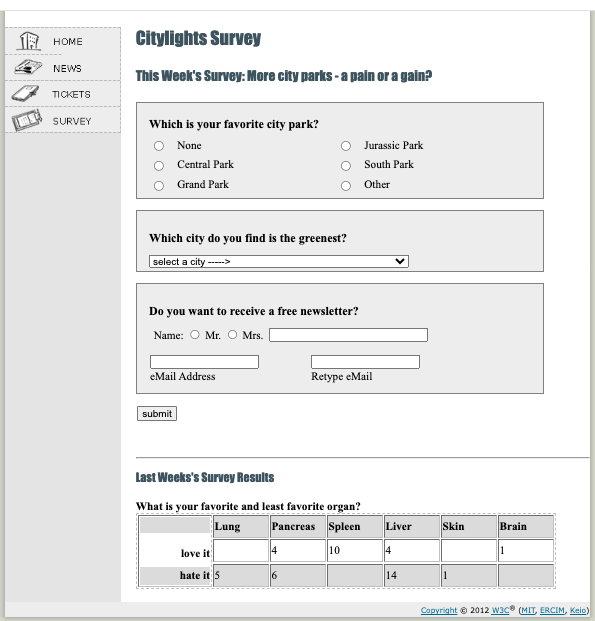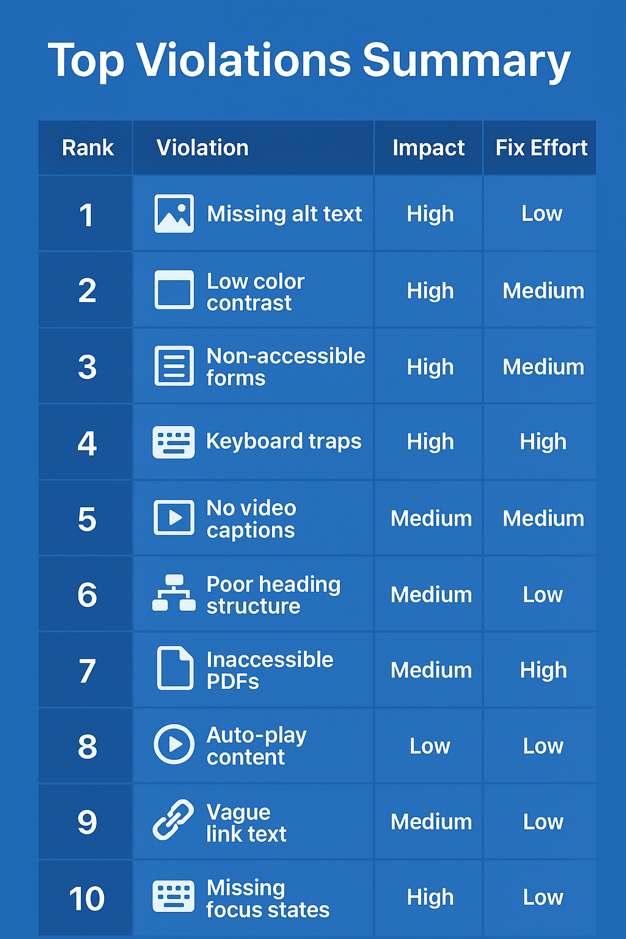
Top 10 WCAG Violations Found on Business Websites
Many business websites have hidden accessibility barriers that stop disabled people from using them easily. Achieve WCAG compliance and expand your reach. Resolving the inaccessibility issues can also protect your business from serial litigants, “law firms” whose sole purpose is to sue thousands of websites under the ADA.
Before we get into the list, let’s start with the basics of WCAG accessibility.
What Is WCAG?
The Web Content Accessibility Guidelines are developed by the World Wide Web Consortium (W3C). WCAG guidelines create an accessibility framework that makes websites and applications usable.
These rules make sure everyone can use your website easily. People who use screen readers can read easily on your site. Those who use only a keyboard can move around without any problem. Also, videos with captions help users who can’t hear well understand your content better.
Q: Which WCAG version should I follow in 2025?
A: Follow WCAG 2.2 AA because it is the current benchmark for most compliance frameworks worldwide.
Related Reading:
Understand WCAG standards in our guide [WCAG 2.2 Compliance: What changed and who is most at risk].
Who needs to follow WCAG guidelines?
Almost every business today should take WCAG compliance seriously. It is non-negotiable if you operate a shopping site, have online forms on your healthcare website or manage learning platforms. Any business with payment gateways or a government sector website must adhere to WCAG.

Don’t want to be the target of serial litigants? Get help now. Achieve total WCAG compliance with industry’s most experienced website accessibility specialists.
Q: Is WCAG compliance legally required?
A: It is legally mandatory for organizations in the US. WCAG aligns with the ADA (Americans with Disabilities Act) in the US. WCAG falls under the Equality Act 2010 in the UK. And, similar rules apply in Canada, Australia, and the EU.
Why Businesses Get It Wrong
Most violations occur because people assume automation tools are enough.
In reality, automated scanners catch only 30–40% of accessibility issues.
Don’t just rely on software scans, manual audits and human-led testing are essential for full compliance.
Not sure if your website is compliant? Get a free WCAG audit consultation today.
Top 10 Common WCAG Violations
Here are the most common accessibility issues our WCAG audit experts see on business websites. Below are some simple fixes for each issue to help you achieve accessibility.
1. Missing Alt Text on Images
Alt text describes what an image shows. If it is incorrect or not present then screen readers cannot tell visually impaired users what’s there.
Tip: Avoid stuffing keywords in alt text; keep it natural.
2. Poor Color Contrast
Text blended into the background becomes unreadable for users with low vision or color blindness.
Fix: You can use contrast checker tools to test contrast between text and background.
3. Non-Accessible Forms
Many online forms don’t have proper labels or instructions. It can confuse users who rely on screen readers.

Source:https://www.w3.org/WAI/demos/bad/before/survey.html
The survey form on the W3C's "Before and After Demonstration" page shows missing form labels. The Input fields lack <label> elements. It becomes difficult for screen reader users to identify the purpose of each field.
Furthermore, there are no instructions or error handling. It leaves users uncertain about how to complete or correct the form. The form's layout and functionality do not support efficient keyboard navigation. A disabled user might not be able to complete the form due to these issues.
Learn more about accessible web forms in our WCAG Testing Guide [Quick Wins for WCAG 2.2 Level AA Compliance. 7 ways to improve your website].
4. Keyboard Navigation Failures
Users who can’t use a mouse should be able to navigate your entire site using just the Tab and Enter keys.
Most common mistakes are hidden menus that are not reachable by keyboard and forms that skip the focus order.
Test every page manually using only the keyboard. If you cannot reach something, neither can your users.
5. Missing Video Captions and Transcripts
Videos without captions exclude users who are deaf or hard of hearing. So, add captions/subtitles for videos and provide a written transcript for audio.
YouTube’s auto-captions are not enough. Always review and edit them.
Q: Can I fix WCAG issues myself?
A: Yes, you can handle simple issues like color contrast or alt text. But for full audits and WCAG certification, consult ADACP.
6. Improper Heading Structure
Headings help assistive technologies understand page hierarchy. Skipping heading levels or using them for design breaks this structure.
Follow this heading order example:
• <h1> Page title
• <h2> Section title
• <h3> Subtopic
Q: How do I test my website for WCAG violations?
A: Use free WCAG compliance checker tools for quick scans. Make sure you always pair them with a human-led audit to find real-world issues.
7. Inaccessible PDFs
Many businesses upload reports or brochures as PDFs that aren’t tagged properly for screen readers.
Easy fixes to make PDFs WCAG compliant:
• Use a PDF accessibility checker tool
• Add proper tags to all headings, paragraphs and tables
• Add alt text for images inside PDFs
Need WCAG testing and remediating for your documents?
Talk to our WCAG experts today.
8. Auto-Playing Media
Videos or animations that play automatically can distract or trigger motion sensitivity issues.
WCAG compliant websites always provide options to disable auto-play. An easy fix would be to offer a Pause/Stop control. Avoid flashing elements if you aim for an inclusive design.
Q: Can animations cause accessibility issues?
A: Yes, fast-flashing visuals can cause dizziness or even seizures in some users. Always offer motion control.
9. Links Without Descriptive Text
“Click here” or “Read more” gives no context for screen readers.
Better WCAG-friendly examples can be like this-
1. “Download the WCAG 2.2 checklist”
2. “Read our Accessibility Certification Guide”
See our full post on How to Get WCAG Certified. Don’t be confused because WCAG itself is not a certification. Learn how businesses invest in VPAT reports and compliance audits to meet accessibility standards.
10. Lack of Focus Indicators
Keyboard users need visible cues (like outlines) to know where they are on a page.
Without this, keyboard users may get lost in long forms or menus.

These WCAG violations may seem small to you, but their impact is huge. If self-fixes are not possible, consult ADACP today.
Conclusion
Ignoring WCAG violations is bad for your business reputation. It damages your SEO visibility and even invites legal penalties. Fix these issues now and protect your business.
Ready to make your website WCAG-compliant?
Book a 30-minute WCAG testing consultation with our accessibility experts. ADACP experts have more than 13 years of experience. We can discover hidden compliance gaps before your customers do.
Many business websites have hidden accessibility barriers that stop disabled people from using them easily. Achieve WCAG compliance and expand your reach. Resolving the inaccessibility issues can also protect your business from serial litigants, “law firms” whose sole purpose is to sue thousands of websites under the ADA.
Before we get into the list, let’s start with the basics of WCAG accessibility.
What Is WCAG?
The Web Content Accessibility Guidelines are developed by the World Wide Web Consortium (W3C). WCAG guidelines create an accessibility framework that makes websites and applications usable.
These rules make sure everyone can use your website easily. People who use screen readers can read easily on your site. Those who use only a keyboard can move around without any problem. Also, videos with captions help users who can’t hear well understand your content better.
Q: Which WCAG version should I follow in 2025?
A: Follow WCAG 2.2 AA because it is the current benchmark for most compliance frameworks worldwide.
Related Reading:
Understand WCAG standards in our guide [WCAG 2.2 Compliance: What changed and who is most at risk].
Who needs to follow WCAG guidelines?
Almost every business today should take WCAG compliance seriously. It is non-negotiable if you operate a shopping site, have online forms on your healthcare website or manage learning platforms. Any business with payment gateways or a government sector website must adhere to WCAG.

Don’t want to be the target of serial litigants? Get help now. Achieve total WCAG compliance with industry’s most experienced website accessibility specialists.
Q: Is WCAG compliance legally required?
A: It is legally mandatory for organizations in the US. WCAG aligns with the ADA (Americans with Disabilities Act) in the US. WCAG falls under the Equality Act 2010 in the UK. And, similar rules apply in Canada, Australia, and the EU.
Why Businesses Get It Wrong
Most violations occur because people assume automation tools are enough.
In reality, automated scanners catch only 30–40% of accessibility issues.
Don’t just rely on software scans, manual audits and human-led testing are essential for full compliance.
Not sure if your website is compliant? Get a free WCAG audit consultation today.
Top 10 Common WCAG Violations
Here are the most common accessibility issues our WCAG audit experts see on business websites. Below are some simple fixes for each issue to help you achieve accessibility.
1. Missing Alt Text on Images
Alt text describes what an image shows. If it is incorrect or not present then screen readers cannot tell visually impaired users what’s there.
Tip: Avoid stuffing keywords in alt text; keep it natural.
2. Poor Color Contrast
Text blended into the background becomes unreadable for users with low vision or color blindness.
Fix: You can use contrast checker tools to test contrast between text and background.
3. Non-Accessible Forms
Many online forms don’t have proper labels or instructions. It can confuse users who rely on screen readers.

Source:https://www.w3.org/WAI/demos/bad/before/survey.html
The survey form on the W3C's "Before and After Demonstration" page shows missing form labels. The Input fields lack <label> elements. It becomes difficult for screen reader users to identify the purpose of each field.
Furthermore, there are no instructions or error handling. It leaves users uncertain about how to complete or correct the form. The form's layout and functionality do not support efficient keyboard navigation. A disabled user might not be able to complete the form due to these issues.
Learn more about accessible web forms in our WCAG Testing Guide [Quick Wins for WCAG 2.2 Level AA Compliance. 7 ways to improve your website].
4. Keyboard Navigation Failures
Users who can’t use a mouse should be able to navigate your entire site using just the Tab and Enter keys.
Most common mistakes are hidden menus that are not reachable by keyboard and forms that skip the focus order.
Test every page manually using only the keyboard. If you cannot reach something, neither can your users.
5. Missing Video Captions and Transcripts
Videos without captions exclude users who are deaf or hard of hearing. So, add captions/subtitles for videos and provide a written transcript for audio.
YouTube’s auto-captions are not enough. Always review and edit them.
Q: Can I fix WCAG issues myself?
A: Yes, you can handle simple issues like color contrast or alt text. But for full audits and WCAG certification, consult ADACP.
6. Improper Heading Structure
Headings help assistive technologies understand page hierarchy. Skipping heading levels or using them for design breaks this structure.
Follow this heading order example:
• <h1> Page title
• <h2> Section title
• <h3> Subtopic
Q: How do I test my website for WCAG violations?
A: Use free WCAG compliance checker tools for quick scans. Make sure you always pair them with a human-led audit to find real-world issues.
7. Inaccessible PDFs
Many businesses upload reports or brochures as PDFs that aren’t tagged properly for screen readers.
Easy fixes to make PDFs WCAG compliant:
• Use a PDF accessibility checker tool
• Add proper tags to all headings, paragraphs and tables
• Add alt text for images inside PDFs
Need WCAG testing and remediating for your documents?
Talk to our WCAG experts today.
8. Auto-Playing Media
Videos or animations that play automatically can distract or trigger motion sensitivity issues.
WCAG compliant websites always provide options to disable auto-play. An easy fix would be to offer a Pause/Stop control. Avoid flashing elements if you aim for an inclusive design.
Q: Can animations cause accessibility issues?
A: Yes, fast-flashing visuals can cause dizziness or even seizures in some users. Always offer motion control.
9. Links Without Descriptive Text
“Click here” or “Read more” gives no context for screen readers.
Better WCAG-friendly examples can be like this-
1. “Download the WCAG 2.2 checklist”
2. “Read our Accessibility Certification Guide”
See our full post on How to Get WCAG Certified. Don’t be confused because WCAG itself is not a certification. Learn how businesses invest in VPAT reports and compliance audits to meet accessibility standards.
10. Lack of Focus Indicators
Keyboard users need visible cues (like outlines) to know where they are on a page.
Without this, keyboard users may get lost in long forms or menus.

These WCAG violations may seem small to you, but their impact is huge. If self-fixes are not possible, consult ADACP today.
Conclusion
Ignoring WCAG violations is bad for your business reputation. It damages your SEO visibility and even invites legal penalties. Fix these issues now and protect your business.
Ready to make your website WCAG-compliant?
Book a 30-minute WCAG testing consultation with our accessibility experts. ADACP experts have more than 13 years of experience. We can discover hidden compliance gaps before your customers do.

We will contact you shortly.





.svg)
.svg)
.svg)
.webp)























.svg)

.svg)